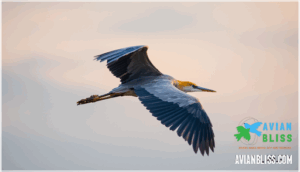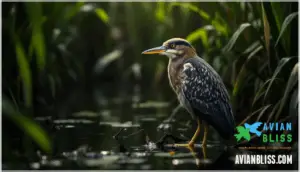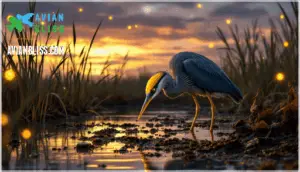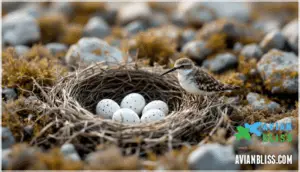This site is supported by our readers. We may earn a commission, at no cost to you, if you purchase through links.

This thick-necked specialist dominates coastal marshes and inland swamps across the southeastern United States, where crustaceans make up over 95% of its diet. While it’s listed as Least Concern globally, regional populations face mounting pressures from habitat loss and declining water quality.
Understanding this nocturnal hunter’s identification markers, habitat preferences, and mating rituals helps you spot one of North America’s most specialized wading birds.
Table Of Contents
- Key Takeaways
- Yellow-crowned Night Heron Identification
- Habitat Preferences and Geographic Range
- Diet and Foraging Behavior
- Breeding and Nesting Habits
- Conservation Status and Ecological Role
- Frequently Asked Questions (FAQs)
- What does a yellow crowned night heron eat?
- What is a yellow crowned night heron?
- When do yellow crowned night herons breed?
- Do they have any natural predators?
- How do they interact with other heron species?
- What are their courtship rituals like?
- How do they adapt to urban environments?
- How long do yellow-crowned night herons live?
- What sounds or calls do they make?
- How do they differ from other heron species?
- Conclusion
Key Takeaways
- The Yellow-crowned Night Heron is a specialized crustacean hunter with over 95% of its diet consisting of crabs and crayfish, using a thick, powerful bill to crack shells and foraging primarily at night in coastal marshes and inland swamps.
- You can identify adults by their stocky build, all-gray body, bold black-and-white face mask, and yellowish legs that extend well past the tail in flight, while juveniles appear dark brown with white streaks and notably longer legs than similar species.
- Though globally listed as Least Concern, regional populations face serious threats from wetland destruction, water pollution, and habitat loss, with some states like Indiana and Pennsylvania listing the species as endangered or threatened.
- These herons have adapted surprisingly well to urban environments, nesting in city parks and residential areas, and serve as important indicators of wetland health by controlling crustacean populations and signaling clean water conditions.
Yellow-crowned Night Heron Identification
Spotting a Yellow-crowned Night Heron isn’t hard once you know what to look for. These chunky, medium-sized herons have a few key features that set them apart from their relatives.
Let’s walk through the physical traits that’ll help you identify one in the field.
Size, Shape, and Wingspan
You’ll spot a Yellow-crowned Night Heron by its compact, heavy-set frame—stocky body, thick neck, and blocky head that give it a powerful silhouette whether it’s perched or gliding overhead.
These birds measure 22-27 inches in length with a wingspan reaching 3’8". Their short, thick legs and relatively short bill add to their sturdy appearance.
In flight, you’ll notice their broad, rounded wings with a distinctive fingered shape that sets them apart from other herons.
Adult Plumage and Coloration
Adult Yellow-crowned Night Herons wear a striking gray coat with a bold black-and-white facial pattern that makes them easy to recognize once they’ve shed their juvenile feathers. Their plumage showcases these distinctive physical characteristics:
- All-gray body coloration that contrasts sharply with the head markings
- Black-and-white face pattern creating a memorable appearance
- Whitish head plumes that develop during breeding season, adding elegance to their profile
These color patterns remain consistent across their range with minimal regional differences.
Juvenile Appearance
Young Yellow-crowned Night Herons look nothing like their sleek gray parents—they’re cloaked in dark brown feathers covered with white streaks and spots that help them blend into shadowy wetland vegetation. This immature plumage persists until the juvenile develops adult coloration.
You’ll notice their all-dark bill is noticeably heavier than a Black-crowned Night-Heron chick’s bill, and their legs are distinctly longer—key features for flight ID when you’re watching from a distance.
Bill, Legs, and Flight Posture
When you watch a Yellow-crowned Night Heron up close, the thick, short bill and sturdy yellow legs give it a compact, powerful look. In flight, those legs stretch well beyond the tail, while broad, rounded wings show distinct finger-like tips at the ends. These physical characteristics help with field identification:
- Bill morphology: All-dark and heavier than Black-crowned relatives
- Leg length: Extends noticeably past tail in flight
- Flight posture: Broad, fingered wingtips on rounded wings
- Juvenile differences: Longer legs distinguish young birds from similar species
Habitat Preferences and Geographic Range
Yellow-crowned Night Herons don’t just pick any wetland to call home—they’re drawn to specific types of habitats where crustaceans thrive. You’ll find these stocky herons along coastal marshes and tidal zones, but they’ve also adapted to inland swamps and even urban settings.
Let’s look at where you’re most likely to spot them throughout the year.
Coastal and Inland Wetlands
Yellow-crowned Night Herons don’t just pick any waterside spot to call home—they’re looking for places where their favorite crustacean meals are plentiful and easy to catch. You’ll find them in coastal marshes, tidal mudflats, and mangrove swamps where crabs thrive. Inland, they favor river basin swamps and forested wetlands rich with crayfish.
Water quality and ecosystem services directly impact their habitat preferences, making wetland conservation critical against coastal development and habitat degradation.
Regional Distribution in North America
From Massachusetts south to Florida and west to Oklahoma, you’ll find Yellow-crowned Night Herons breeding along the Atlantic coastal plain and extending inland to Tennessee, Kentucky, and Illinois. Their breeding range limits reach as far north as Michigan and Ontario, though northern populations are sparse.
Wintering strongholds include southern Florida, the Gulf Coast, and Mexico, where crustaceans remain active year-round. Migration patterns show northward dispersal after breeding, then southward movement by September.
Population density varies considerably—the species is locally common in coastal Texas and southeastern states but rare and state-endangered in Pennsylvania, where only 8-12 nests are monitored annually. These birds are considered crab and crustacean specialists.
Urban and Suburban Adaptations
You might be surprised to spot these herons nesting in city parks, residential neighborhoods, and even parking lot trees—they’ve quietly adapted to human-dominated landscapes better than most waterbirds. Urban wooded areas provide suitable nesting sites, though light pollution disrupts their nocturnal foraging patterns.
Habitat fragmentation in suburbs forces dietary shifts toward earthworms and insects when crabs aren’t accessible. Despite urban nesting challenges, these birds tolerate human interaction remarkably well, raising young successfully just feet from sidewalks and busy streets.
Seasonal Range Changes
Climate-driven shifts are rewriting migration patterns across the species’ range. Most populations migrate to Panama and northern South America for winter, but milder winters now enable occasional overwintering in mid-Atlantic states like Virginia and the Carolinas—areas once abandoned entirely.
Southern Florida hosts year-round resident populations, while breeding range expansion northward continues as spring temperatures warm earlier, affecting migration timing and habitat availability across their geographic distribution and range.
Data for these migrations are available through eBird data providers.
Diet and Foraging Behavior
If you want to understand what makes the Yellow-crowned Night Heron tick, start with what it eats. This species has some very particular food preferences that shape where it lives and how it spends its time.
Let’s look at what’s on the menu, how it hunts, and what influences its feeding schedule.
Primary Prey: Crustaceans and Crabs
If there’s one thing this heron won’t compromise on, it’s crabs. Crustaceans make up over 95% of their diet, with crabs and crayfish dominating the menu. Coastal birds target fiddler crabs and blue crabs, while inland populations focus on freshwater crayfish.
This crustacean feeding specialist shows striking dietary variation across regions—prey morphology and habitat impact foraging success. Their sturdy bill cracks shells up to 30 mm wide, making them perfectly adapted for crustacean-rich wetlands.
Secondary Food Sources
While crabs rule the plate, these herons don’t turn down an occasional side dish when it’s within reach. When crustaceans are scarce, you’ll find them sampling:
- Mollusks like snails and mussels
- Fish in shallow pools
- Amphibians including frogs and tadpoles
- Insects such as beetles and aquatic larvae
- Reptiles like small snakes
This flexible feeding pattern helps them survive when their preferred prey isn’t available.
Foraging Techniques and Feeding Times
These birds hunt with a patience that would put most fishermen to shame, standing motionless in shallow water or creeping along the shoreline until the perfect moment to strike. You’ll spot them feeding at dusk and through the night—their peak nocturnal hunting hours—though they’re active during daylight too.
They grab crustaceans with quick jabs of their stout bills, maintaining about 15 feet between foraging neighbors along the water’s edge.
Tidal and Seasonal Influences
When you’re hunting crabs and crayfish for a living, your schedule isn’t set by a clock—it’s dictated by the tides and what’s crawling around that particular season. Coastal breeding populations adjust their tidal foraging around low tide exposures, when prey becomes accessible.
Seasonal diet shifts follow precipitation cycles and wetland conditions—crayfish populations peak in late summer, while habitat availability fluctuates with migratory patterns influenced by El Niño and La Niña events in tidal waters.
Breeding and Nesting Habits
Yellow-crowned Night Herons follow predictable patterns regarding raising their young. Their nesting actions involve specific site selection, careful timing, and shared parental duties that increase survival rates.
Here’s what you need to know about how these herons breed and care for their offspring.
Nesting Locations and Materials
From towering mangrove tangles along the coast to shaded wooded groves near urban bayous, yellow-crowned night herons choose nesting spots that offer both protection and proximity to their favorite hunting grounds. You’ll find their nests built as simple twig platforms in forested wetlands, shrubs on barrier islands, or even city trees—urban nesting adaptations that showcase their flexibility.
Nest site fidelity runs strong, with colonies returning to the same breeding habitat for over 20 years. Colony size variations range from solitary pairs to several hundred, though most trees host just one nest.
Breeding Season and Timing
Once nests are in place, the timing of breeding follows a predictable schedule that stretches from early March through mid-July across most of North America. Regional variations shift the breeding season slightly—southern populations start earlier, while northern herons wait until late spring.
Nesting synchronicity helps protect colonies, with eggs recorded from late March to mid-June. This timing sustains fledgling success when crustacean prey peaks, supporting healthy clutch size and successful egg incubation through the warm months.
Egg-laying, Incubation, and Chick Development
After eggs are laid—usually two to four pale blue-green ovals—both parents share incubation duties for about three weeks, rotating on and off the nest with quiet precision.
Egg size averages around 51 x 37 mm, and the incubation period lasts 21-25 days. Once hatched, chicks depend entirely on parental care, receiving regurgitated crustaceans directly into their beaks.
Young birds fledge in roughly 30 days and achieve independent flight by 50 days, indicating successful fledging success when prey availability aids growth.
Courtship Displays and Parental Roles
Before the first egg even appears, you’ll notice something striking: the male’s legs shift from dull yellow to vivid coral or scarlet, signaling he’s ready to court and claim territory. These mating rituals include behavioral displays like bowing and bill-snapping during the breeding season.
Once paired, both parents share incubation periods and nestling care equally—this cooperative breeding strengthens parental investment. They perform greeting ceremonies when switching nest duties, reinforcing their bond throughout parental care.
Conservation Status and Ecological Role
The Yellow-crowned Night Heron is currently listed as Least Concern by the IUCN, but that doesn’t mean it’s without challenges. Habitat loss and declining water quality threaten local populations in some regions, especially where wetlands are disappearing.
Let’s look at what this means for the species and why these herons matter so much to the ecosystems they call home.
IUCN Classification and Population Trends
Globally, the IUCN classifies this species as Least Concern, but regional differences tell a more complex story. Population estimates range from 76,000 to 400,000 individuals, though monitoring challenges due to nocturnal habits complicate accurate counts.
Conservation concerns vary by state—you’ll find it listed as Endangered in Indiana and Threatened in Pennsylvania. Distribution shifts have occurred since the 1920s, with northward range expansion followed by recent declines in some areas.
Conservation status and surveys reveal a Continental Concern Score of 12 out of 20, reflecting moderate worry about population dynamics and survival despite stable overall trends.
Threats: Habitat Loss and Water Quality
You’re watching the impact of environmental factors strip away critical habitat for Yellow-crowned Night Herons. Wetland destruction, water pollution, and urban encroachment combine to threaten their survival. Climate change threats like sea-level rise make things worse.
Four key pressures deserve your attention:
- Wetland habitat importance shrinks as over 50% of original U.S. wetlands disappear, eliminating nesting and foraging sites
- Water pollution degrades prey availability, causing crayfish and crab populations to collapse from toxic runoff
- Urban encroachment displaces colonies, with human disturbance forcing abandonment even in established nesting areas
- Prey decline accelerates as habitat destruction disrupts aquatic food webs supporting crustacean populations
Conservation status reflects these mounting pressures on vulnerable populations.
Conservation Efforts and Monitoring
You’ll find protection for Yellow-crowned Night Herons under the Migratory Bird Treaty Act, with additional state-level safeguards in Illinois, Indiana, Kentucky, Pennsylvania, and Wisconsin.
Population surveys like New York’s Colonial Waterbird counts (41 pairs at 3 sites in 2022) and the NYC Bird Alliance’s annual monitoring since 1985 track breeding success.
Habitat management focuses on wetland restoration and reducing human disturbance at nesting colonies.
Research gaps remain around juvenile distribution and climate change threats affecting crustacean prey.
Community science through eBird and collaborative partnerships strengthen conservation efforts despite the species’ current IUCN status as Least Concern.
Importance in Wetland Ecosystems
Yellow-crowned Night Herons act as living barometers of wetland health, their presence signaling thriving crustacean populations and clean water conditions that benefit countless other species.
These herons signal wetland health—their presence means thriving crabs, crayfish, and clean water supporting entire ecosystems
By controlling crab and crayfish numbers, they influence trophic cascades throughout aquatic ecosystems. Their foraging aids nutrient cycling, redistributing energy across food webs.
As bioindicators, they reveal wetland conditions that affect habitat provision for wetland birds and coastal ecosystems alike.
Frequently Asked Questions (FAQs)
What does a yellow crowned night heron eat?
Crustaceans dominate this bird’s feeding habits, making up over 95% of its diet.
Crabs are the primary target in coastal areas, while inland crayfish can account for 74% of consumption in wetland habitats during late summer.
What is a yellow crowned night heron?
This stocky wader belongs to the night heron family, recognized by its thick neck, large blocky head, and distinctive gray body with bold black-and-white facial markings in adults.
When do yellow crowned night herons breed?
Breeding triggers start surprisingly early—some pairs begin courtship in March, nearly eight weeks before summer officially starts. The breeding season runs from early March through mid-July, with regional variations affecting timing.
You’ll find nesting actions peak when temperatures warm and food becomes abundant. Both parents share parental care duties during the 21-25 day incubation period. Clutch size averages 2-4 eggs, and nesting success depends heavily on habitat quality and food availability.
Yellow-crowned Night Herons often form colonies, ranging from solitary pairs to hundreds of nests, with some sites persisting for over 20 years.
Do they have any natural predators?
Nest predation poses the greatest threat to these herons’ survival. Crows, raccoons, opossums, and domestic dogs and cats target eggs and young birds.
Adults face virtually no direct predators, making juvenile vulnerability the primary conservation concern.
How do they interact with other heron species?
Herons and egrets often share feeding grounds, but competition for food and space can lead to territorial disputes.
You’ll notice yellow-crowned night herons usually forage separately from black-crowned night-herons by targeting different prey—crabs versus fish—which reduces direct conflict through habitat partitioning.
What are their courtship rituals like?
During courtship, you’ll notice dramatic leg coloration changes—from yellowish to coral pink or scarlet.
Males perform ritualistic actions, including bill clapping and greeting ceremonies, strengthening pair bonding through synchronized displays and soft vocalizations before mating.
How do they adapt to urban environments?
You mightn’t expect it, but these birds thrive near people. They nest in urban wooded areas, hunt crayfish in city parks, and adjust foraging times around light pollution.
Habitat fragmentation doesn’t stop them—they’ve mastered human interaction while maintaining natural diet and feeding habits.
How long do yellow-crowned night herons live?
Lifespan factors like habitat quality, diet availability, and mortality causes influence average longevity. The oldest recorded yellow-crowned night heron lived at least six years, though limited captivity lifespan data exists.
Conservation efforts protect these birds through conduct and wetland preservation.
What sounds or calls do they make?
When you hear sharp, harsh squawks piercing through the twilight, you’re likely tuned into a yellow-crowned night heron’s voice. Their vocalization includes loud squawks used as alarm and aggression calls, particularly during takeoff.
While young chicks produce soft chu-chu-chu calls, these sounds intensify with age.
How do they differ from other heron species?
Compared to similar heron species, this bird stands out with its thicker, all-black bill and noticeably longer legs.
The Black-crowned Night-Heron has a thinner bill and shorter legs, with feet that don’t extend as far beyond the tail in flight.
Conclusion
Spotting a yellow crowned night heron is like discovering a hidden treasure in plain sight—these stocky specialists practically vanish among shadowy mangroves and moonlit marshes. Once you recognize that bold face mask, stocky build, and patient hunting style, you’ll never mistake this crab-eating master for its lankier cousins.
Whether you’re scanning tidal creeks or urban ponds, knowing their diet, range, and breeding habits transforms every wetland walk into a thrilling search for one of North America’s most focused predators.
- https://macaulaylibrary.org/photo/64330621
- http://www.kaufmanfieldguides.com/
- http://www.mbr-pwr.usgs.gov/bbs/bbs.html
- https://www.heronconservation.org/herons-of-the-world/list-of-herons/yellow-crowned-night-heron/
- https://extapps.dec.ny.gov/fs/programs/dfw/SWAP2025/Birds/Yellow-crowned%20night%20heron%20SSA.pdf











